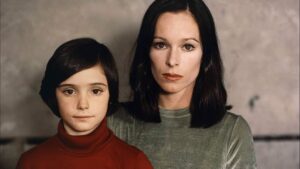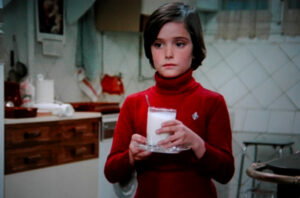“Cría Cuervos”/ “Raise Ravens” – a Bitter Taste of Childhood

Title: “Cria cuervos” (“Raise Ravens”)
Release Date: 1974
Director: Carlos Saura
Cast: Ana Torrent, Geraldine Chaplin, Florinda Chico, Hector Alterio, German Cobos, Mirta Miller, Mayte Sanchez, Conchita Perez, Monica Randall
One of Carlos Saura’s most famous films shows human helplessness in the face of a heartless fate. “Cría Cuervos”, starring Ana Torrent and Geraldine Chaplin, is an image of paradise lost.
“Raise Ravens” belongs to Saur’s cycle in which the director paints a picture of Francoist Spain. Already at the beginning of the film there is an allusion to an earlier work, “Cousin Angelica”. We see the reflection of little Ana and her mother in the mirror, combing the girl’s hair. “Cousin Angelica” ends with a similar shot. The slow combing of hair is almost ritualistic, a kind of solace for the child. It makes the world seem safe and good, as everything is watched over by a gentle mother who can handle all the fears that torment the girl. However, the mother is only a projection of the child’s imagination – she is really dead, and reality is dangerous and sad.
“Raise Ravens” is a film that tells the story of a difficult childhood of a nine-year-old Ana (played by Ana Torrent). In a short period of time she and her two sisters experience the death of both their parents. First her depressed mother (Geraldine Chaplin) dies, then her father, who dies during a passionate night with his lover. Ana, her siblings and disabled grandmother are taken in by her unmarried aunt Pauline (Monica Randall), her mother’s sister. Neverteless, she cannot come to terms with her new situation. She even wishes for the death of her unfeeling caretaker, just as she previously dreamed of killing her father. In the end, however, the protagonist will have to accept her fate. The film ends with the scene of the return to school after the summer vacations, which is synonymous with the power of everyday routine that gives life a fixed framework.

“Raise Ravens” – a painful initiation into the world order
Ana from “Cría Cuervos” is forced to face prematurely the most dramatic experiences that will change her life forever. We are dealing here with a different model of childhood than the classical one. It is not a carefree paradise, but a period of great suffering. Death and loneliness ultimately destroy the sense of security, and their power over human existence seems unlimited. The absurdity and tragedy of death are emphasized in the film by the dark atmosphere and enclosed space. The huge house, but also the garden of the aunt’s friends does not seem to be an oasis of peace, but rather a prison from which there is no escape.
Interestingly, the garden is also where Ana is initiated into the world of sex. When her mother sends her to look for her father, the girl discovers that he is kissing another woman in the bushes. This is an allusion to the biblical Eden and the sin of the first humans. Dying is thus inextricably linked to sin, which becomes understandable against the background of strict Spanish Christian ethics. The theme of death even permeates the world of children’s games. During a game of hide-and-seek, for example, the girls “die” as if they were fictitious, and they can only be revived by praying to the Guardian Angel.
“Raise Ravens” – the power of children’s imagination
Ana’s suffering is compounded by her complete lack of understanding of what is happening. A little girl does not understand much of the adult world, so she builds her own imaginative vision of reality. Ana is convinced that her mother is dying because of her father’s infidelity. The girl witnessed her parents’ argument, during which the woman shouted that she wanted to die. The heroine misses her mother so much that she decides to bring justice to the world herself.

Among her childhood treasures she has a box with a mysterious substance, which once her mother told her to throw away, claiming that there is poison in it. So Ana puts some of the powder in her father’s drink and then does the same with her aunt’s milk. Nonetheless, this does not work – the poison is not real. Ana therefore discovers that her chosen method of taking control of the cruel world is only an illusion. Pain and death come when they want and no one has any power over them. This is the absurdity inherent in human existence.
“Raise Ravens” – “Feed the ravens and they will gouge out your eyes”.
However, the most poignant feature of Ana’s painful experience is not only the gaining of awareness of evil, but also the fact that with its discovery, the protagonist herself is marked by it. This is how the title of Carlos Saura’s film could be interpreted, referring to a Spanish proverb that says: “feed the ravens and they will gouge out your eyes”.
Furthermore, the most striking feature of Ana’s painful experience is not only the gaining of awareness of evil, but also the fact that with its discovery, the protagonist herself becomes marked by it. This is how the title of Carlos Saura’s film could be interpreted, referring to a Spanish proverb that says: “feed the ravens and they will gouge out your eyes”.
The ravens symbolize these tragic experiences and emotions, which always have a self-destructive dimension. Ana, wishing to restore justice, resorts to transgression herself, which marks her with the stigma of guilt. Although the poison turns out to be a simple foodstuff, the nine-year-old girl is convinced of its deadly effect. In this way, the protagonist enters a world in which the experience of pain is constantly intertwined with its infliction. Just like in the words of Jeanette’s song, which is the musical leitmotif of the film – “All the promises of my love will leave with you” – suffering forever changes the human face.
Literature:
E. Królikowska, „Śladami Buñuela. Kino hiszpańskie”, Warszawa 1988.
